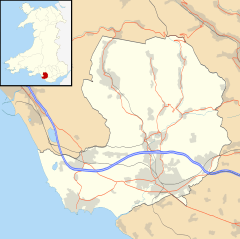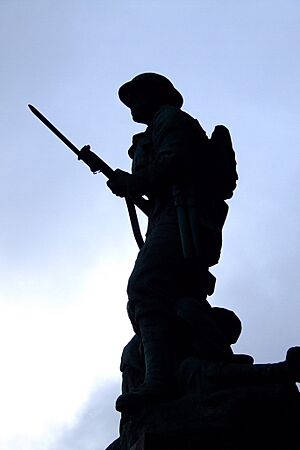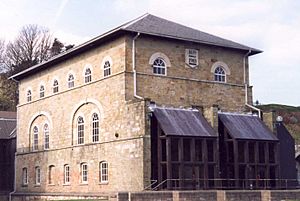Maesteg facts for kids
Quick facts for kids Maesteg |
|
|---|---|
|
From the top, Maesteg Town Hall, Commercial Street, Hartshorn House
|
|
| Population | 21,000 (2011) |
| OS grid reference | SS855915 |
| • Cardiff | 27.5 |
| • London | 173.0 |
| Community |
|
| Principal area |
|
| Ceremonial county | |
| Country | Wales |
| Sovereign state | United Kingdom |
| Post town | MAESTEG |
| Postcode district | CF34 |
| Dialling code | 01656 |
| Police | South Wales |
| Fire | South Wales |
| Ambulance | Welsh |
| EU Parliament | Wales |
| UK Parliament |
|
| Welsh Assembly |
|
Maesteg (/ˈmaɪˌstɛɡ/ ) is a town and community in Bridgend County Borough, Wales. It sits at the very top of the Llynfi Valley, near the border with Neath Port Talbot. In 2011, Maesteg had about 20,612 people living there. The name Maesteg means 'fair field' in English.
Long ago, Maesteg was part of Glamorgan. The town started to grow in the 1820s and 1830s when ironworks were built. It used to be a big coal mining area, but the last coal mine closed in 1985. Now, with fewer factories and mines, many people who live in Maesteg travel to work in places like Port Talbot, Bridgend, and Cardiff. About 11% of the town's people speak Welsh. Among kids aged 3-15, about 27.9% speak Welsh! Maesteg is also one of the few places in Wales where the traditional Mari Lwyd celebration still happens during Christmas.
The community of Maesteg had 17,580 people in 2011. This number includes the nearby village of Nantyffyllon. The total built-up area had a population of 21,000.
Contents
History of Maesteg
Before factories and mines came in the 1820s, the Llynfi Valley was mostly empty, with just a few farms. The closest village was Llangynwyd, about two miles south of where Maesteg town centre is now. Near Llangynwyd, there's an old earthwork called Y Bwlwarcau (meaning "the bulwarks"). This was an Iron Age fort, showing that people lived here a very long time ago.
During the Middle Ages, the valley was called Tir Iarll (the Earl's Land). It was a beautiful area with lots of game, woods, and streams. Robert Fitzhamon, a Norman conqueror, used it as a hunting reserve. Until the 1700s, many farms in the Llynfi Valley were important places for local culture. For example, Llwydarth, where the powerful Powell family lived, was a hub for writers and poets in the 1600s.
Interestingly, Maesteg was the first place in the UK where Japanese knotweed was seen growing in the wild. This was sometime before 1886.
Industrial Past
The modern community in the Llynfi Valley began in the late 1820s. This is when people started to use the area's rich coal and iron ore on a large scale. In 1828, a 15-mile railway was built between Porthcawl and Garnlwyd. Horses pulled the trains on this railway, called the Dyffryn Llynfi and Porthcawl Railway (DLPR). It was later extended to the Coegnant area in 1830.
This railway helped the area grow. An iron company started building a factory on Maesteg Uchaf Farm in 1826. By 1831, two blast furnaces were working, and homes for workers were built nearby. Around the same time, one of the first zinc factories in Wales was set up near the railway's end.
In 1839, a second, even bigger, ironworks began at Nantycrynwydd Farm. This factory became known as the Llynfi Ironworks. Today, the Tesco store and its car park are mostly on this site. Part of the Maesteg Sports Centre, called the Cornstores, and the base of an old blast furnace are still there. These are reminders of the valley's important iron industry from the 1800s.
These two ironworks, along with their coal mines and new homes, changed the area. In 1821, it was just a few farms with about 400 people. By 1841, it was a growing town with 4,000 people!
Famous people invested in these ironworks. The poet William Wordsworth owned shares in the Cambrian company in the 1840s. Sir Felix Booth, who made gin, and Dr John Bowring, a writer and politician, also invested. Bowring put a lot of money into the Llynfi Works in the mid-1840s. For a few years, the area around his factory was even called Bowrington. John Bowring also helped create Britain's first decimal coin, the florin (now the ten pence piece). He later became the Governor of Hong Kong.
Iron making in Maesteg continued until the 1870s. That's when cheaper, mass-produced steel took over. The Llynfi Works was known for making high-quality iron. They even exported iron to places like Southern Italy and Turkey. But because the factory couldn't make steel, iron production stopped in Maesteg in 1885.
In the mid-1880s, with the ironworks closing, Maesteg faced a tough time. But then, the local coal industry started to grow. New companies, like North's Navigation Collieries Ltd, opened mines. By 1921, the population had grown from 10,000 to almost 30,000 people!
Between 1890 and 1925, the valley became famous for its high-quality steam coal. This coal was so good that North's Imperial Navigation coal was on a special list of the best Welsh steam coals. In 1908, the famous ship Mauretania used only Llynfi coal when it set a new record for crossing the Atlantic Ocean.
By the early 1920s, over 7,000 miners worked in the valley. However, the area relied heavily on selling coal to other countries. So, it was badly affected by the Great Depression from 1928 to 1938. During this time, many people were very poor and couldn't find jobs. The population of the Llynfi Valley dropped by almost a third as people left to find work elsewhere.
After World War II, the local coal industry still employed over 2,000 workers for many years. New jobs also came from factories built by the government and new industries in nearby Port Talbot and Bridgend. Because of the busy coal industry and new factories, Maesteg's population stayed around 20,000 from 1950 to 1975. As more jobs appeared in Bridgend and Port Talbot, the Llynfi Valley slowly became a place where people lived but worked elsewhere. This happened even faster when the coal industry finally ended between 1977 and 1985.
Llynfi Valley Metal-Working Centres
| Name | In Production | Maximum Workforce |
|---|---|---|
| Coegnant Spelter (zinc) Works | 1830–1847 | 95 in 1839 |
| Maesteg Iron Works | 1828–1860 | 561 in 1841 |
| Llynfi Iron Works | 1839–1885 | 2,000 in 1870 |
| Llwydarth Tinplate Works | 1868–1900 | 470 in 1886 |
Llynfi Valley Collieries
| Name | Sinking Commenced | Year of Closure | Maximum Workforce |
|---|---|---|---|
| Garth | 1864 | 1930 | 1,007 in 1907 |
| Oakwood (Davis's Pit) | 1868 | 1928 | 495 in 1899 |
| Coegnant, | 1881 | 1981 | 2,182 in 1914 |
| Caerau | 1890 | 1977 | 2,432 in 1922 |
| Maesteg Deep | 1868 | 1930 | 671 in 1910 |
| St John's (Cwmdu) | 1908 | 1985 | 1,479 in 1920 |
People of Maesteg (Demography)
Demography is the study of populations. Here's a look at the people living in Maesteg:
| 2011 Census | ||||
|---|---|---|---|---|
| Population of Maesteg Community (all ages) (17,580) | 100% | |||
| Number of people speaking Welsh (Maesteg) (1,867) | 11% | |||
| :Average in Wales | 19% | |||
| Number born in Wales (Maesteg) (16319) | 92.8% | |||
| :Average in Wales | 73% | |||
| Number in work between 16 and 74 years of age(Maesteg) (3,412) | 45.2% | |||
| :Average in Wales | 67.1% | |||
Economy
Maesteg Market
Maesteg Market was located on the ground floor of Maesteg Town Hall. It used to sell many different things, but the last seller left in 2018.
Getting Around (Transport)
Railway
Maesteg has three train stations on the Maesteg Line. Trains are run by Transport for Wales Rail and go directly to Cardiff Central through Bridgend. These trains usually continue to Cheltenham Spa.
The last station on the line is Maesteg. The other two stations are Maesteg (Ewenny Road) and Garth station. Garth station serves the villages of Garth and Cwmfelin, which are just outside Maesteg.
In the past, Maesteg had other train stations that are now closed. The original Maesteg station was a bit west of the current one. You can still see parts of it, like the platforms, behind the Asda supermarket.
Buses
Maesteg bus station is behind the town hall. First Cymru runs most of the bus services from here. You can catch buses to Bridgend, Swansea (via Port Talbot), Caerau Park, Llangynwyd, and Cymmer.
Welsh Language
Like the rest of Wales, Maesteg has two official languages: English and Welsh. Most people in Maesteg speak English, but a group of people also speak Welsh. The 2011 census showed that 11% of people over 3 years old spoke Welsh.
However, the number of Welsh speakers changes a lot with age. About 27.9% of 3-15 year olds speak Welsh. This drops to 8.6% for 16-64 year olds, and only 5.3% for people over 65.
You can learn in Welsh at both primary and secondary schools in Maesteg. There are also Welsh-language churches. The main office for Menter yr Iaith Pen-y-bont ar Ogwr, which promotes the Welsh language, is in Maesteg. Norah Isaac, a Welsh author and champion for Welsh-medium education, was born and grew up in Caerau. She was very important in the history of Welsh-medium education. Wales' first ever Welsh-language nursery opened in Maesteg in 1949.
Education
Maesteg has six state primary schools where lessons are taught in English: Cwmfelin, Plasnewydd, Caerau, Nantyffyllon, Llangynwyd, and Garth. Plasnewydd is one of the largest primary schools in the Llynfi Valley, with over 400 students. It is also an Eco-School. There is also a Catholic primary school, St. Mary's and St. Patrick's, and a Welsh-medium school, Ysgol Cynwyd Sant.
There are two comprehensive schools in Maesteg. The English-medium Ysgol Maesteg School recently moved to a new building that cost £17 million. The Welsh-medium Ysgol Gyfun Gymraeg Llangynwyd then moved into the old school building.
Students from St. Mary's and St. Patrick's Catholic primary school go on to Archbishop McGrath Catholic Comprehensive School in Brackla.
Maesteg Town Council
Maesteg Town Council has seventeen members. These members represent four different areas: Maesteg East, Maesteg West, Nantyffyllon, and Caerau. For over forty years, the Labour party had the most members on the council. Recently, some councillors left the Labour party and now serve as independent members. As of June 2019, the council has 9 Labour members and 8 Llynfi Independents.
Religion
The main religion in the valley is Christianity. Most churches here are Nonconformist, meaning they are not part of the Church of England. There are many churches and chapels in Maesteg. Some of them are no longer used for religious services and have been turned into apartments. There is also a Kingdom Hall for Jehovah's Witnesses in Nantyffyllon.
Culture
Maesteg has a strong tradition of music and theatre, especially singing. There are two male voice choirs: Cor Meibion Maesteg A'r Cylch and Maesteg Gleemen Male Voice Choir. Maesteg Gleemen is the most successful male voice choir in the area.
There is also a women's choir called Harmony Ladies Choir. Two mixed groups are Noteworthy Choir and Take Note.
Maesteg Musical Theatre Society puts on a musical and a concert every year. Maesteg Children's Choir also holds many concerts. Curtain Up Youth Theatre has been performing musicals for over twenty years.
The rock band Funeral for a Friend is from Maesteg.
The Welsh national anthem, "Hen Wlad Fy Nhadau", was first performed in Maesteg. This happened in the small room of the original Capel Tabor, which is now the Maesteg Workingmen's Club.
The artist Christopher Williams was born in Maesteg in 1873. Seven of his paintings are on display in the town hall.
Media
Maesteg is part of Bridgend County Borough. The local radio station is Bridge FM. Maesteg is also close enough to hear radio stations from Swansea, like Hits Radio South Wales and Swansea Bay Radio.
The town has three local newspapers:
- The Glamorgan Gazette is published every week. Its main office is in Bridgend, but it prints news about Maesteg.
- The Gem (formerly The Recorder) is a free weekly paper printed in Cowbridge.
- The Llynfi News is a free monthly paper based in Maesteg.
Sport
Maesteg is home to Maesteg Park A.F.C., a association football (soccer) team started in 1945. There are four Welsh Rugby Union teams in Maesteg. The oldest is Maesteg RFC, founded in 1877. Maesteg Harlequins RFC was formed in the 1920s. Other rugby union teams include Nantyffyllon RFC and Maesteg Celtic RFC. Maesteg also used to have a rugby league team called South Wales Scorpions, but it no longer exists.
The town has two cricket clubs. Maesteg Cricket Club started in 1846 and won a league cup in 2016. Maesteg Celtic Cricket Club is based at Garth Welfare Park. They have won the Welsh Cup three times and their league seven times, including four times in a row! Both clubs play in the South Wales Cricket Association Division 1.
Famous People from Maesteg
- Billy Banks (1925-1991), a rugby league player for Wales and Great Britain.
- Allan Bateman, a rugby union and rugby league player for Wales and the British Lions.
- Dave Bowen (1928–1995), a footballer and manager for Arsenal and Wales.
- Henry Bracy (1846–1917), an opera singer and director.
- Gwyn Evans, a rugby union player for Wales and the British Lions.
- Howell Evans (1928-2014), an actor.
- Chico Hopkins, a rugby union and rugby league player for Wales and the British Lions.
- Norah Isaac (1915-2003), an author and a key figure in Welsh-language education.
- George Jeffries (1889–1972), who started the Elim Pentecostal Church.
- Siân Lloyd (1958-), an ITV weather presenter.
- James Morgan (1985-), an actor.
- Sir Rhys Hopkin Morris (1888–1956), a politician and the first director of BBC Wales.
- Sir William Beddoe Rees MP (1877–1931), a Welsh architect and politician.
- Brinley Richards (1904–1981), Archdruid of Wales from 1972–75.
- Menna Richards, Controller of BBC Wales from 2000–2011.
- David Emlyn Thomas (1892–1954), a politician and trade union leader.
- Rees Thomas (1926-1984), a rugby league player.
- Thomas Llyfnwy Thomas (1912–1983), a singer and TV personality in the U.S.
- Sidney Wilcox (1893–1973), a cricketer.
- Christopher Williams (1873–1934), a painter.
- John J. Williams (1948–2020), a rugby union player for Wales and the British Lions, and an international athlete.
See also
 In Spanish: Maesteg para niños
In Spanish: Maesteg para niños







